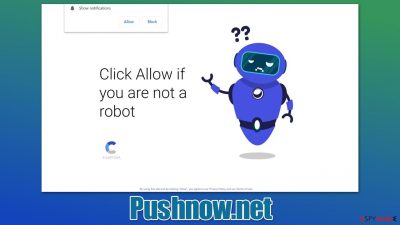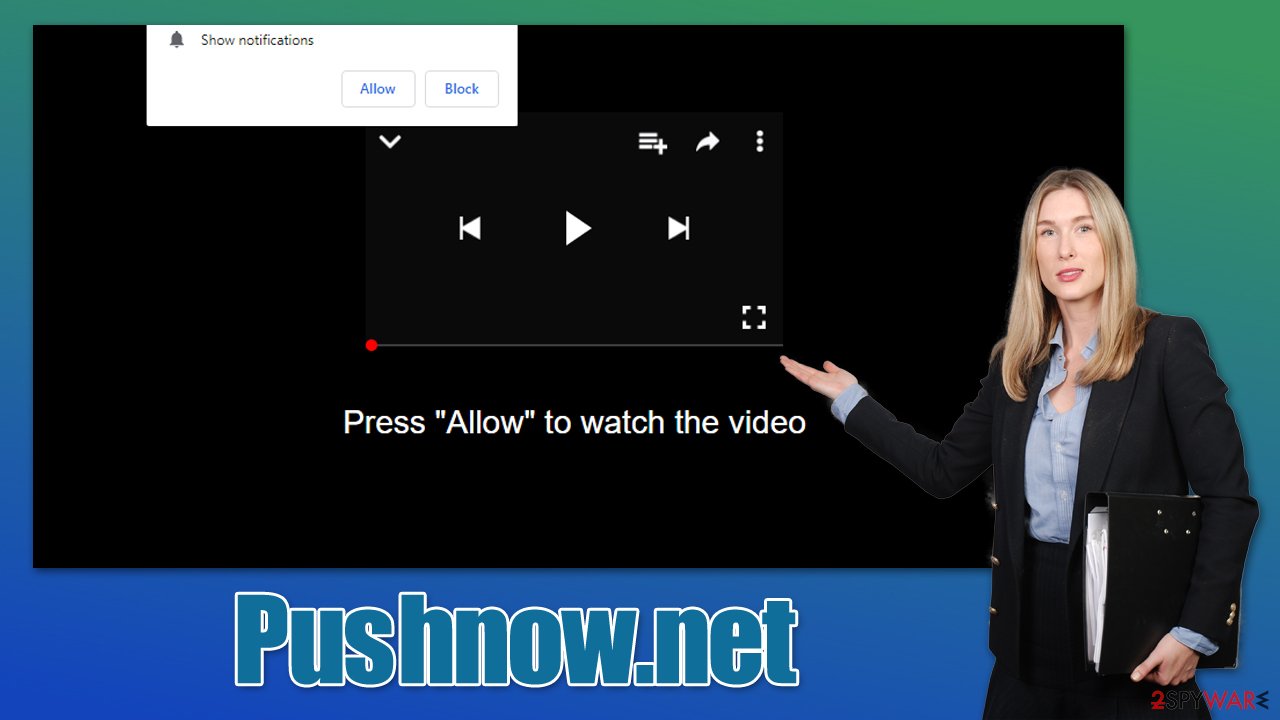Pushnow.net ads (scam) - Tutorial
Pushnow.net ads Removal Guide
What is Pushnow.net ads?
Pushnow.net shows intrusive pop-ups that can link you to malicious websites

Pushnow.net ads might start showing up on your screen unexpectedly one day, and you are not alone who have encountered this problem recently. Many users complained that the pop-ups show up regardless of which website they are currently visiting or whether they are actively using the browser at all. The activity would disappear as soon as the browser is turned off fully, however.
This happens because Pushnow.net pop-ups are caused by requests of this site and since users allowed notifications from it, they can be delivered at any time and include any type of information. In most cases, they include all sorts of misleading or malicious messages that lead to dangerous websites, hence clicking them is not recommended. Instead, please follow the instructions below to learn how to eliminate the annoying notifications even when the browser is on.
| Name | Pushnow.net |
| Type | Push notifications, ads, pop-ups, scam |
| Distribution | When the “Allow” button within the notification prompt is clicked |
| Symptoms | Pop-ups show up on a regular basis on the screen – these ads often include inappropriate, scam, phishing, or other similar content |
| Risks | Shown popups incorporate fake notices and push scams. Links can also lead to websites filled with malware |
| Removal | Access browser settings to stop intrusive push notifications. After that, make sure that your system is not infected with adware or malware – scan it with SpyHunter 5Combo Cleaner |
| Security tips | Make sure you clean your browsers after you delete PUPs from the system. To do that automatically, you can use FortectIntego |
Are push notifications and pop-up ads the same?
There is a fundamental difference between pop-up ads encountered on random websites and push notifications, even if they might look almost identical. The push notification feature is an API that is embedded in every modern web browser and allows any website to use it. It allows that particular website to deliver notifications in a specific area on the system level if employed. There are two conditions for this activity to materialize, which include:
- Users should accept the request to show notifications by clicking the “Allow” button within the prompt.
- The browser must be running (it does not matter if it is actively used or is simply idling in the background.
Evidently, authors of fake and malicious websites tend to abuse this feature and begin sending malicious ads – this usually happens due to insecure advertising networks used by scammers.
Pop-up ads, on the contrary, are triggered when users enter the website that hosts them, so they wouldn't see them outside of that environment. Alternatively, a very aggressive form of adware might be the cause of intrusive pop-up ads.
Scam messages used
There are thousands of push notification scams around in the wild, and they are all hosted on specially crafted websites, which are entirely fake, and their only purpose is to make sure that users accept the request to show push notifications.
For that, scammers employ various social engineering techniques that some users might not be familiar with. For example, this is one of the most common messages that various scam sites employ:
Click Allow if you are not a robot
This is usually accompanied by a picture of a human and a robot, which people might misinterpret as a valid verification method that so many websites use to defend themselves from dangerous DDoS attacks. In other cases, users might be told that the browser is not allowing video playback or that the “18+” verification is required to proceed.

Once the “Allow” button is pressed, users never get what they are promised, and instead, they are redirected to other malicious websites, including Thefreeadv.com, Up-date.safecorp.org, Goodcaptcha.top, and many others, where they could be asked to do the exact same thing.
Why is it important to check your system for adware
Adware is a type of software that is distributed along with freeware or spread via fake updates or other misleading ads. Once installed, it might start showing deals, offers, banners, coupons, and other commercial content when users browse the web. In some cases, it also comes with the changes made to browser settings.
Adware could also be one of the main reasons your encounter fake requests to enable push notifications or see other phishing content online. Authors of potentially unwanted software rarely check the quality of advertising networks that they use, which often results in users being exposed to misleading or even malicious ads.
Therefore, you should check your system for adware and other infections. The most effective way of doing so is by scanning your system with SpyHunter 5Combo Cleaner, Malwarebytes, or another powerful anti-malware software. This would guarantee that all the malicious components are eliminated at once. After that, we also recommend using FortectIntego to clean web browsers and also fix damaged system components automatically.
Remove push notifications from malicious websites easily
Since Pushnow.net ads are shown on the system level, many users automatically assume that their systems have been infected with a virus. However, security software would not be able to stop the activity, as it is not technically an infection. Instead, the affected users should access the settings of their browsers and block access to the Pushnow.net address.
Google Chrome
- Open Google Chrome browser and go to Menu > Settings.
- Scroll down and click on Advanced.
- Locate the Privacy and security section and pick Site Settings > Notifications.
- Look at the Allow section and look for a suspicious URL.
- Click the three vertical dots next to it and pick Block. This should remove unwanted notifications from Google Chrome.
![Stop notifications on Chrome PC 2 Stop notifications on Chrome PC 2]()
Mozilla Firefox
- Open Mozilla Firefox and go to Menu > Options.
- Click on Privacy & Security section.
- Under Permissions, you should be able to see Notifications. Click the Settings button next to it.
- In the Settings – Notification Permissions window, click on the drop-down menu by the URL in question.
- Select Block and then click on Save Changes. This should remove unwanted notifications from Mozilla Firefox.
![Stop notifications on Mozilla Firefox 2 Stop notifications on Mozilla Firefox 2]()
Safari
- Click on Safari > Preferences…
- Go to the Websites tab and, under General, select Notifications.
- Select the web address in question, click the drop-down menu and select Deny.
![Stop notifications on Safari Stop notifications on Safari]()
MS Edge
- Open Microsoft Edge, and click the Settings and more button (three horizontal dots) at the top-right of the window.
- Select Settings and then go to Advanced.
- Under Website permissions, pick Manage permissions and select the URL in question.
- Toggle the switch to the left to turn notifications off on Microsoft Edge.
![Stop notifications on Edge 2 Stop notifications on Edge 2]()
MS Edge (Chromium)
- Open Microsoft Edge, and go to Settings.
- Select Site permissions.
- Go to Notifications on the right.
- Under Allow, you will find the unwanted entry.
- Click on More actions and select Block.
![Stop notifications on Edge Chromium Stop notifications on Edge Chromium]()
Internet Explorer
- Open Internet Explorer, and click on the Gear icon at the top-right of the window.
- Select Internet options and go to the Privacy tab.
- In the Pop-up Blocker section, click on Settings.
![Stop notifications on Internet Explorer Stop notifications on Internet Explorer]()
- Locate web address in question under Allowed sites and pick Remove.
How to prevent from getting adware
Access your website securely from any location
When you work on the domain, site, blog, or different project that requires constant management, content creation, or coding, you may need to connect to the server and content management service more often. The best solution for creating a tighter network could be a dedicated/fixed IP address.
If you make your IP address static and set to your device, you can connect to the CMS from any location and do not create any additional issues for the server or network manager that needs to monitor connections and activities. VPN software providers like Private Internet Access can help you with such settings and offer the option to control the online reputation and manage projects easily from any part of the world.
Recover files after data-affecting malware attacks
While much of the data can be accidentally deleted due to various reasons, malware is one of the main culprits that can cause loss of pictures, documents, videos, and other important files. More serious malware infections lead to significant data loss when your documents, system files, and images get encrypted. In particular, ransomware is is a type of malware that focuses on such functions, so your files become useless without an ability to access them.
Even though there is little to no possibility to recover after file-locking threats, some applications have features for data recovery in the system. In some cases, Data Recovery Pro can also help to recover at least some portion of your data after data-locking virus infection or general cyber infection.






